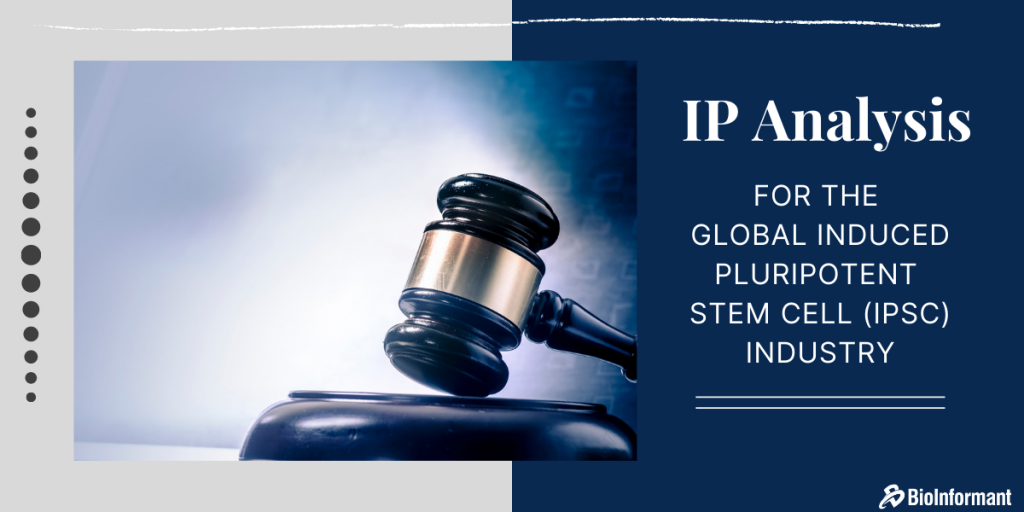Induced pluripotent stem cells (iPSCs) are a unique type of stem cell that can be developed from somatic cells by inserting genes that transform them into an embryonic-like state. These artificially-developed pluripotent cells can proliferate and self-renew indefinitely in vitro, as well as differentiate into different types of specialized cells.
iPSCs have numerous applications related to basic research, drug screening, toxicological studies, disease modeling, cell therapy and personalized medicine. iPSCs can be used to explore the causes of disease onset and progression, create and test new drugs and therapies, and be potentially, treat previously incurable diseases. The somatic cells used for reprogramming include skin cells and blood cells, and to a lesser degree, other readily accessible cell types such hair follicles, cord blood and urine.
iPSC Patent Analysis
Currently, the U.S. is the largest target market for pluripotent stem cell (PSC) technology, with more than 2,850 patent families filed. This accounts for more than 50% of the total patent families filed from 2006 to present. Europe is the second largest target market with over 1,800 patent families. China is the third largest market, with over 1,600 patent families filed, followed closely by Japan, Korea and Canada, respectively.
Recently released, one of the key features of BioInformant’s 238-page “Global Induced Pluripotent Stem Cell Report” is its intellectual property (IP) section. This comprehensive section features eight Topics, two Tables, and ten Figures, as shown below:
5.1 Timeline and Status of Patents
5.2 Patent Filing Destinations
5.2.1 Patent Applicant’s Origin
5.2.2 Top Ten Global Patent Applicants
5.2.3 Top Ten Collaborating Applicants of Patents
5.3 Patent Application Trends iPSC Preparation Technologies
5.4 Patent Application Trends in iPSC Differentiation Technologies
5.5 Patent Application Trends in Disease-Specific Cell Technologies
TABLE 5.1: Patent Families by Filing Jurisdiction
TABLE 5.2: Patents Granted and Patents Pending in the Global Patent Landscape
FIGURE 5.1: Number of Patents Granted, Being Sought and “Dead”
FIGURE 5.2: Patent Families by Filing Jurisdiction
FIGURE 5.3: Patent Families by Applicant Origin
FIGURE 5.4: Top Ten Global Applicants
FIGURE 5.5: Top Ten Global Collaborators on PSC/iPSC Patents
FIGURE 5.6: Share of Patents on iPSC Preparation Technologies by Geography
FIGURE 5.7: Percent Share of iPSC Preparation Methods in the U.S., Japan and Europe
FIGURE 5.8: Percent Share of Patents Related to Cell Types Differentiated from iPSCs
FIGURE 5.9: Percent Share of Patent Applications for Disease-Specific Cell Technologies
FIGURE 5.10: Percent Share of Patents Representing Different Disorders
(View the report’s full Table of Contents here.)
Why Does the iPSC Intellectual Property Landscape Matter?
Why does the iPSC intellectual property (IP) landscape matter? It matters for several reasons, the first of which is that there has been a swell of patents controlling various pluripotent stem cell technologies. Applicants for patents are required to file patents in each country in which they wish to have patent protection. Meaning, companies must seek patent protection anywhere they intend to commercialize products or set up manufacturing.
Since 2006 when Kyoto University filed its first patent application for iPSCs, iPSC patents have expanded dramatically. While there are regional differences, common areas of focus include genetically engineered cells, drug screening technologies, and disease-specific cell technologies.
Also of importance is that there have been major lawsuits pursued within the iPSC sector in recent years. Of particular note is a patent lawsuit between Cellular Dynamics International, Inc. and Lonza Walkersville, Inc. This patent lawsuit relates to whether CDI (a FUJIFILM Company) and WARF have sufficiently proven that Lonza infringed on their iPSC patent claims. Lonza is a multinational biotech company headquartered in Switzerland.
Expertise in iPSC Market Dynamics
Why does BioInformant track the global iPSC market sector? Again, there are several reasons, with the first being that BioInformant is the first and only market research firm in the world to specialize in the stem cell market. With an online readership of nearly one million viewers per year, BioInformant is a U.S. market research firm that is strategically positioned to be near the National Institutes of Health (NIH), the U.S. FDA, the Maryland Biotech Corridor, and policy makers on Capital Hill.
Founded in 2006, our focus on the stem cell industry allows us to acquire specialized knowledge and access. Since its inception, BioInformant has collected 15 years of historical data on the global iPSC market. Meaning, we have tracked this sector since the Japanese scientist Shinya Yamanaka first demonstrated that an ordinary cell can be turned into a pluripotent cell by genetic modification.
In contrast, other market analysis companies are “generalists” who publish superficial reports about a wide range of topics that they know little about, such as stem cells, as well as oil, beverages, and electronics.
Our unique expertise also provides us with critical access to key opinion leaders (KOL’s), most of whom are clients and partners of BioInforant. In addition to having 15 years of historical data on the iPSC market, our team of experienced analysts conducts dozens of interviews with iPSC industry leaders, including Kaz Hirao (President and COO of FUJIFILM CDI), Ross Macdonald (CEO of Cynata Therapeutics), Robin Smith (CEO of ORIG3N), Paul Wotton (Board Member of Cynata Therapeutics), and Yutaka Yamaguchi (President of FUJIFILM Irvine Scientific – FISI), among many others.
Global iPSC Market Evolution
In short, we are confident you will not find any other market research team worldwide that is working harder to track the rapidly evolving iPSC market. To access invaluable data points that will illuminate your understanding of this lucrative, ever-expanding market, view the “Global Induced Pluripotent Stem Cell (iPSC) Industry Report.”
